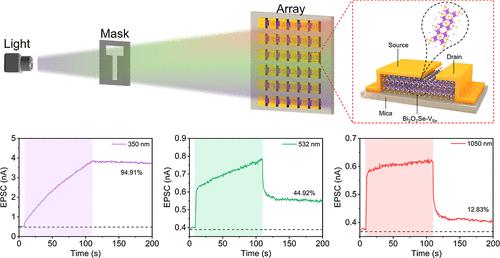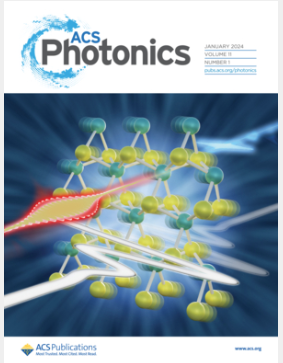Self-Powered and Broadband Optical Synapse Device Based on Se-Vacancy Bi2O2Se for Artificial Vision System Application
IF 6.5
1区 物理与天体物理
Q1 MATERIALS SCIENCE, MULTIDISCIPLINARY
引用次数: 0
Abstract
The optical synaptic devices, inspired by the human visual system and capable of emulating biological synaptic behaviors, have demonstrated significant potential for artificial vision applications. However, contemporary optical synaptic devices are hindered by several limitations, including a narrow response range, intricate structures, compromised stability, and substantial energy demands. Herein, large single-crystal Bi2O2Se nanosheets with selenium vacancies (Bi2O2Se–VSe) were synthesized via physical vapor deposition. Based on the Bi2O2Se–VSe nanosheet, a self-powered, broadband optical synaptic device was developed simply by a straightforward asymmetric contact approach. The device proficiently replicates synaptic functionalities without any electrical power requirement. Furthermore, an artificial vision system comprising a 5 × 5 array of self-powered optical synaptic devices was constructed. Under illumination at wavelengths of 350, 532, and 1050 nm for 100 s, the intensity of the image pattern can be kept at a high memory level of 94.91%, 44.92%, and 12.83% after attenuation of 100 s, which demonstrates the excellent image sensing, learning, and memory storage properties. This research paves the way for further exploration of optical synaptic devices and contributes novel insights into the development of artificial vision systems.

基于 Se-Vacancy Bi2O2Se 的自供电宽带光学突触器件在人工视觉系统中的应用
光学突触装置受人类视觉系统启发,能够模拟生物突触行为,在人工视觉应用方面具有巨大潜力。然而,当代的光学突触设备受到一些限制,包括响应范围狭窄、结构复杂、稳定性差和能量需求大。本文通过物理气相沉积合成了具有硒空位的大型单晶 Bi2O2Se 纳米片(Bi2O2Se-VSe)。在 Bi2O2Se-VSe 纳米片的基础上,通过直接的非对称接触方法开发出了一种自供电的宽带光学突触装置。该装置能在不需要任何电力的情况下熟练地复制突触功能。此外,还构建了一个由 5 × 5 自供电光学突触装置阵列组成的人工视觉系统。在波长分别为 350、532 和 1050 nm 的光照下持续 100 秒,图像图案的强度在衰减 100 秒后仍能保持在 94.91%、44.92% 和 12.83% 的高记忆水平,这证明了该器件具有出色的图像传感、学习和记忆存储特性。这项研究为进一步探索光学突触器件铺平了道路,并为人工视觉系统的开发提供了新的见解。
本文章由计算机程序翻译,如有差异,请以英文原文为准。
求助全文
约1分钟内获得全文
求助全文
来源期刊

ACS Photonics
NANOSCIENCE & NANOTECHNOLOGY-MATERIALS SCIENCE, MULTIDISCIPLINARY
CiteScore
11.90
自引率
5.70%
发文量
438
审稿时长
2.3 months
期刊介绍:
Published as soon as accepted and summarized in monthly issues, ACS Photonics will publish Research Articles, Letters, Perspectives, and Reviews, to encompass the full scope of published research in this field.
 求助内容:
求助内容: 应助结果提醒方式:
应助结果提醒方式:


